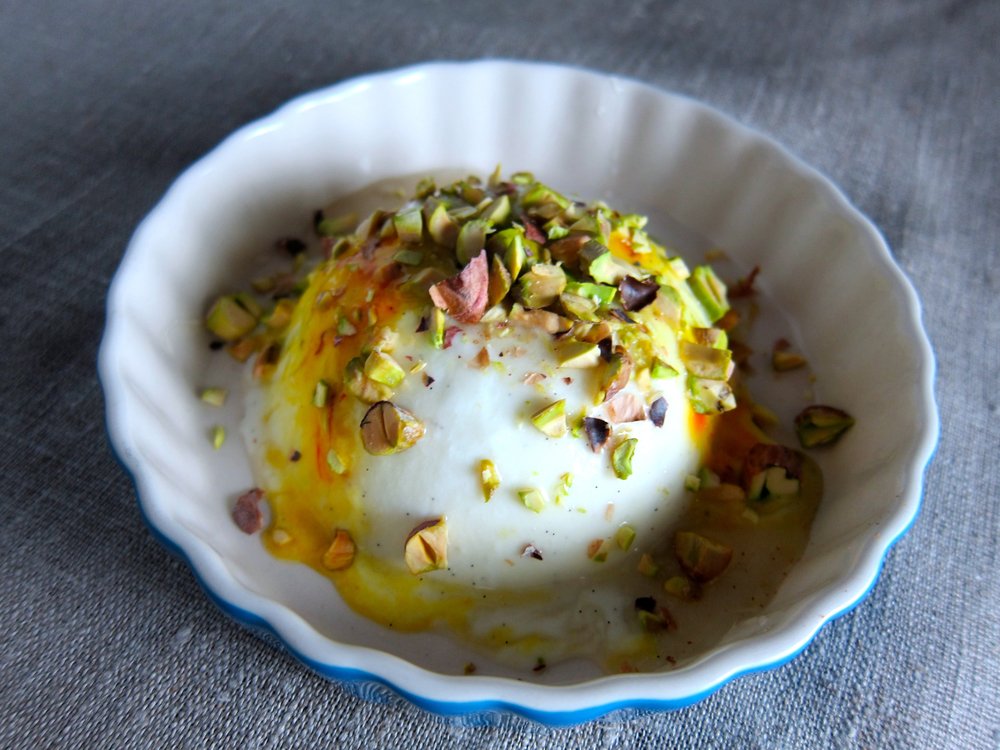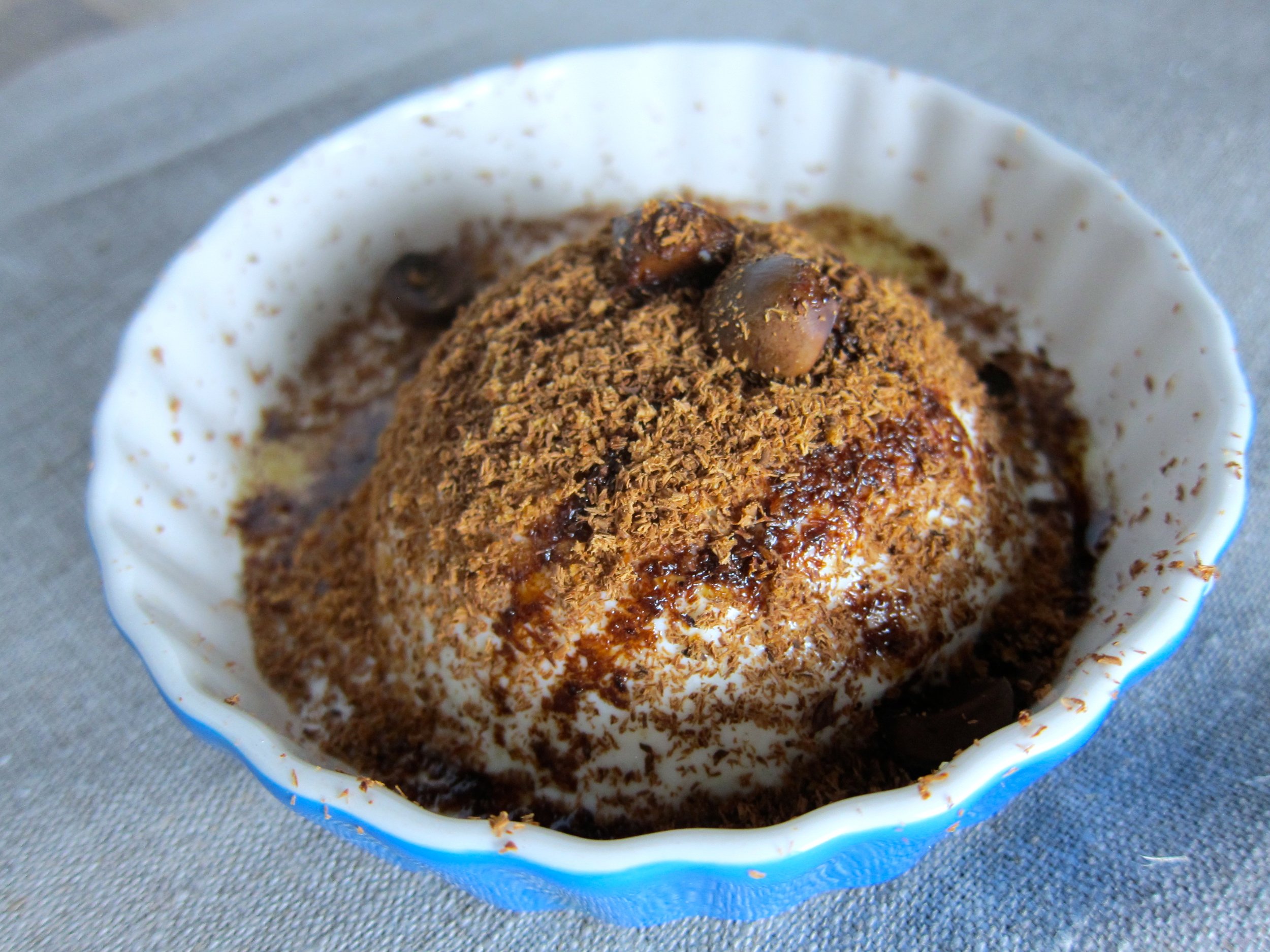Yogurt Panna Cotta with Saffron & Pistachio
For those of you who have not made panna cotta, you might be intimidated by the idea. I was. After all, the results are impressive and seemingly skill-requiring - Italian grandmother slaving away all day skill-requiring. On top of that, panna cotta uses gelatin, something that isn't found in most present-day pantries and comes animal by-product. Yes, traditional panna cotta is not vegetarian.
What if I were to tell you that panna cotta is incredibly easy to make and not only that, it's also very forgiving? By forgiving, I mean that you can adjust the milk to cream ratio, incorporate yogurt or buttermilk, or even play around with dairy-free milks or vegan gelatin and still create a luscious and beautifully wobbly gel. The other great thing about panna cotta is that it's the perfect canvas for a variety of flavor combinations from saffron pistachio to berry compote and nutmeg to dusted dark chocolate or bay nuts.
There's nothing wrong with serving panna cotta in its container with a spoon, but it doesn't require much more work to remove the gel from it's container and put it on a plate and doing this elevates the dessert to very classy level. Recipe below is adapted from a Smitten Kitchen recipe and makes 4 individual servings.
Grapeseed oil, to crease ramekins or other containers used to hold panna cotta
A few saffron threads per panna cotta
1-1/2 teaspoons (or 4 grams) unflavored gelatin
1 cup plain whole-milk yogurt
1/2 cup heavy cream
1/2 cup whole milk
1/4 cup granulated sugar
2 teaspoons lemon juice
1/2 vanilla bean
1/4 cup toasted pistachios, chopped
Honey, to drizzle
Lightly grease containers for panna cotta with grapeseed oil and add a few saffron threads to each container. Ramekins or small cups or bowls work well. Taller/more narrow containers such as jars also work, but make it harder to remove the panna cotta once it has cooled.
Place 2 tablespoons of water in a small bowl. Stir in gelatin and allow to soften, about 10-15 minutes.
In a large bowl, whisk together yogurt with 1/4 cup cream and 1/4 cup milk. Add remaining cream and milk to a saucepan, stir in granulated sugar, and bring to a simmer. Stir in gelatin mixture to dissolve, remove from heat, then whisk into dairy mixture. Scrape the inside of the vanilla bean into mixture along with lemon juice and whisk. Pour into cups, stir once with a fork or chopstick to mix around saffron, and chill in the refrigerator for at least 2 hours. This can be done the night before.
To unmold the cups, fill a saucepan with about 3/4-inch of water and bring to a simmer. Turn off heat and a dip panna cotta cup into the water for 5 seconds, then invert it onto a flat plate. Repeat with remaining cups.
Right before serving, drizzle with honey and top with 1 tablespoon of chopped toasted pistachio. See below for inspiration for other panna cotta variations.
Panna cotta variation with blueberry compote and thyme.
Panna cotta variation with dusted foraged bay nuts and olive oil.
Lebna bil Kusa (summery squash & cumin spread)
Think outside the hummus.

Hummus is the "king (or queen) of spreads", but lebna bil kusa makes a great princess!
I love me some hummus and it has been heartening to know that I am not alone in my enthusiasm - when you see a Super Bowl ad featuring a food, you know that it has truly been adopted by America. This love affair with hummus in the U.S. is so passionate that I even use it as a case study for examining the biocultural factors contributing to cuisine in one of the courses I teach at UC Berkeley. Hummus adheres to many current food trends - among other things, it's plant-based, Mediterranean, healthy, and snackable and, as this Wall Street Journal article discusses, demand has grown to the point that you'd be unlikely to attend any kind of potluck without finding some sort of hummus on the table. Many of the store-bought hummuses you'll find at a potluck however, are made from dried and powdered garbanzo beans, which are incredibly subpar in my opinion (though powdered hummus is great for backpacking). But, I digress - this post is supposed to be about another spread and I promise I'm getting there!
Typically, I'm a hummus purest. Give me a blend of chickpeas, tahini, olive oil, lemon, and salt and I am happy (please don't put garlic in my hummus). I worked for many years off-and-on at an "eclectic Mediterranean" restaurant in Berkeley that is now, sadly, closed. The owners are a husband and wife team, good friends of mine, and most of my Mediterranean cooking skillz I credit to the Iraqi husband. In addition to teaching me to not put garlic in hummus, he showed me that although hummus is still the king of spreads, there are some other contenders that give it a run for its money.
Lebna bill kusa (in Arabic, lebna means "yogurt" and kusa means "squash") is one of those contenders. As it's made with yellow squash, which is only available in summer months, one of the great things about LbK is that it is always a seasonal treat. As a side note, did you know that the straight yellow summer squash is also called "gold bar squash"? Pretty cool and appropriate. The yogurt in LbK nixes it from the list of dishes you can share with your vegan homies, but by upping the tahini/olive oil and adding some lemon juice you can make a vegan version that's almost - but not quite - as good. The recipe specifies a range of quantities because whenever I make it I just kind of mix and match until the consistency and flavor is to my liking. Feel free to add other herbs and spices as desired or make it as thick/thin as you like it! Zucchini would also work, but the color would not be as appealing. Makes about 2 cups.

Yellow summer squash (aka "gold bar squash" shown here) gives lebna bil kusa its bright hue.

1.5 pounds summer squash (about 3 medium "gold bar" squash or 4-6 pattypan or crookneck), chopped
1-2 tablespoons olive oil, divided
1-2 tablespoons tahini
1-2 tablespoons plain yogurt
1-2 teaspoons ground cumin
Salt, to taste

Rustic bread or crackers from whole grains or crisp raw vegetables are a great way to dip up this spread.
Preheat oven to 400 degrees F.
On a baking sheet, toss diced squash with 1/2 tablespoon olive oil and spread out in a single layer. Roast for 12-15 minutes or until soft and golden brown, tossing halfway through.
Using either a food processor or potato masher (food processor if you like your spreads to be smoother, potato masher for chunkier), blend squash with 1/2 tablespoon olive oil, 1 tablespoon tahini, and 1 tablespoon yogurt. Continue adding more of these wet ingredients in small amounts in addition to cumin and salt until you have reached the desired texture and taste.
Serve immediately with crackers, bread, or raw vegetables or store in refrigerator for up to one week. Garnish with paprika, herbs, and drizzled olive oil if desired.
Buttermilk Cornbread
A slice of rustic homespun heaven.

Show me a person who doesn't like cornbread and I'll show you someone that can't be trusted.
Cornbread is really a quickbread, in the same category as your banana and zucchini breads, as it is leavened with baking soda rather than yeast. The use of cornmeal in addition to all-purpose flour gives it the pleasantly grainy quality that we all associate with cornbread. This recipe uses buttermilk or yogurt to give it a delicious tart quality that melds well with the rustic corn.
One of the aspects of cornbread that I personally appreciate is that it can be enjoyed as a savory side dish or a sweet snack, with the addition of butter and honey. Pro-tip: Leftover cornbread + honey + butter + coffee the next morning = a great way to wake up. Makes 9-12 pieces.
“Fun recipe adaptations include adding chopped onions, herbs such as parsley or cilantro, and/or fresh corn kernels off of the cob in the summer time.”
1-1/2 cup yellow cornmeal (medium grind preferred)
1 cup all-purpose flour
1 teaspoon baking soda
1 teaspoon salt
2eggs
2 tablespoons brown sugar
1-1/2 cup buttermilk or plain yogurt
8 tablespoons unsalted butter, melted
Preheat oven to 400, butter an 8-inch square baking dish (or loaf, cake pan, or muffin tins).
In a medium bowl, whisk together cornmeal, flour, baking soda, and salt. In a large bowl, mix together the eggs, brown sugar, and yogurt
Add the dry ingredients to the egg mixture and stir to combine. Stir in melted butter. Pour batter into prepared baking dish
Bake on the middle rack of the oven for 20-25 minutes, or until golden-brown and cooked through.
Cool in pan for 10 minutes before cutting into squares to serve.








